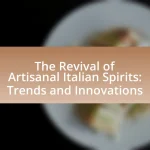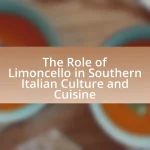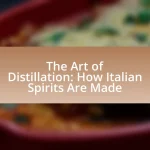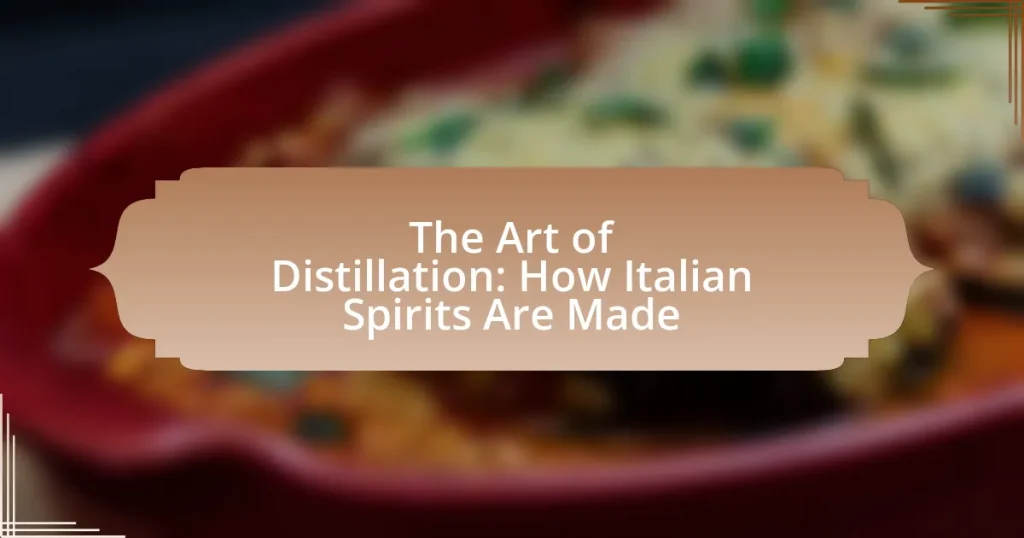The main entity of the article is the art of distillation in Italian spirits, which encompasses the intricate process of separating alcohol from fermented ingredients to produce high-quality beverages such as grappa, limoncello, and amaro. The article details the distillation process, including key stages like heating, vaporization, condensation, and collection, and discusses how different methods impact the flavor, aroma, and purity of the final products. It also highlights the significance of regional differences in ingredient selection and production techniques, as well as the innovations enhancing traditional methods. Additionally, the article explores the unique characteristics of various Italian spirits and offers best practices for serving and pairing them with food.

What is the Art of Distillation in Italian Spirits?
The Art of Distillation in Italian Spirits refers to the precise process of separating alcohol from fermented ingredients to create high-quality spirits such as grappa, limoncello, and amaro. This technique involves heating a fermented mash in a still, where the alcohol vapor rises and is then condensed back into liquid form, allowing for the extraction of flavors and aromas unique to the ingredients used. Italian distillation often employs traditional methods, such as pot stills, which enhance the character of the spirit, and the process is regulated by laws that ensure quality and authenticity, such as those governing the production of grappa, which must be made from pomace of grapes grown in specific regions.
How does the distillation process work in Italian spirit production?
The distillation process in Italian spirit production involves heating fermented liquids to separate alcohol from water and other components. This process typically occurs in pot stills or column stills, where the liquid is heated, causing the alcohol to vaporize. The vapor then rises through the still, where it cools and condenses back into liquid form, resulting in a higher concentration of alcohol.
In Italy, this method is essential for producing various spirits, such as grappa and limoncello, which require specific temperatures and techniques to achieve desired flavors and aromas. For instance, grappa is distilled from grape pomace, and the distillation must be carefully controlled to preserve the unique characteristics of the grapes used. The quality of the raw materials and the distillation technique directly influence the final product’s taste and quality, making this process a crucial aspect of Italian spirit production.
What are the key stages of the distillation process?
The key stages of the distillation process are heating, vaporization, condensation, and collection. In the heating stage, the liquid mixture is heated to a temperature where the desired component vaporizes. During vaporization, the vapor rises through a column or still, separating it from the other components based on boiling points. In the condensation stage, the vapor is cooled, typically using a condenser, transforming it back into liquid form. Finally, in the collection stage, the distilled liquid is collected for further processing or bottling. This process is essential in producing high-quality spirits, as it effectively separates alcohol from impurities, ensuring a refined product.
How do different distillation methods impact the final product?
Different distillation methods significantly impact the final product’s flavor, aroma, and purity. For instance, pot still distillation typically produces spirits with richer flavors and more complex aromas due to the retention of more congeners, while column still distillation results in a higher purity and a cleaner taste by removing more impurities and volatile compounds. The choice of method influences the character of the spirit; for example, traditional Italian grappa is often made using pot stills to enhance its robust flavor profile, whereas vodka, which requires a neutral taste, is usually distilled in columns. This distinction illustrates how the distillation technique directly correlates with the sensory attributes of the final spirit.
Why is distillation important for Italian spirits?
Distillation is crucial for Italian spirits because it purifies and concentrates the flavors and aromas from the raw ingredients. This process allows for the extraction of essential oils and compounds that define the character of spirits like grappa, limoncello, and amaro. For instance, the traditional pot still method used in grappa production enhances the unique characteristics of the grape pomace, resulting in a spirit that reflects the terroir of the region. Additionally, distillation ensures the removal of impurities and unwanted substances, leading to a smoother and more refined final product, which is essential for maintaining the high quality associated with Italian spirits.
What role does distillation play in flavor development?
Distillation plays a crucial role in flavor development by separating volatile compounds from the fermented mash or wash, concentrating desirable flavors while removing unwanted impurities. This process allows distillers to enhance specific flavor profiles, as different distillation techniques can emphasize various aromatic compounds. For example, pot still distillation retains more of the original flavors from the raw materials, while column still distillation produces a cleaner spirit with higher alcohol content and less flavor complexity. The precise control over temperature and pressure during distillation further influences the final flavor, enabling distillers to craft spirits that reflect the characteristics of their ingredients and the desired end product.
How does distillation affect the purity and quality of spirits?
Distillation significantly enhances the purity and quality of spirits by separating alcohol from impurities and unwanted compounds. This process involves heating the fermented liquid to create vapor, which is then cooled to form liquid, effectively concentrating the alcohol while removing substances like methanol and fusel oils that can negatively impact flavor and safety. Research indicates that higher distillation techniques, such as multiple distillations, can lead to spirits with greater clarity and smoother taste profiles, as evidenced by the production methods of high-quality Italian spirits like grappa and limoncello, which often undergo double or triple distillation to achieve optimal purity and flavor.
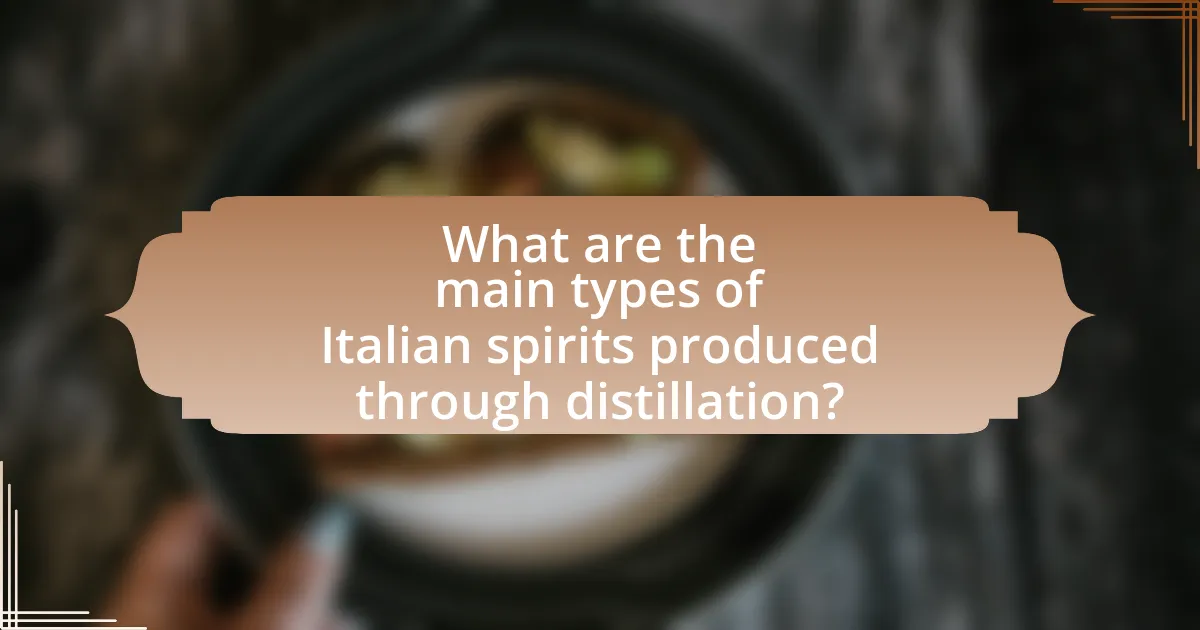
What are the main types of Italian spirits produced through distillation?
The main types of Italian spirits produced through distillation include Grappa, Limoncello, Amaro, and Vermouth. Grappa is a pomace brandy made from the leftover grape skins, seeds, and stems after winemaking, and it has been produced since the 15th century. Limoncello is a lemon liqueur originating from Southern Italy, typically made by infusing lemon zest in alcohol. Amaro is a herbal liqueur that varies in flavor and bitterness, often consumed as a digestif, with roots tracing back to the 19th century. Vermouth is a fortified wine flavored with various botanicals, including herbs and spices, and has been a key ingredient in cocktails since the late 18th century. These spirits reflect Italy’s rich tradition of distillation and regional ingredients.
What distinguishes Grappa from other Italian spirits?
Grappa is distinguished from other Italian spirits primarily by its production method, which involves distilling the pomace, or leftover grape skins, seeds, and stems, after winemaking. This process results in a spirit that captures the essence of the grape variety used, making Grappa unique in flavor and character compared to other Italian spirits like Limoncello or Amaretto, which are made from different base ingredients. Additionally, Grappa must be produced in Italy and adhere to specific regulations, including being made from Italian grapes, further setting it apart from other spirits.
How is Grappa made and what are its unique characteristics?
Grappa is made through the distillation of pomace, which consists of the leftover grape skins, seeds, and stems after winemaking. The process begins with the fermentation of this pomace, where residual sugars are converted into alcohol. Following fermentation, the pomace is distilled, typically in pot stills or column stills, to extract the alcohol and flavors. The resulting spirit is then often aged in wooden barrels, which can impart additional flavors and complexity.
Unique characteristics of Grappa include its high alcohol content, typically ranging from 37.5% to 60% ABV, and its distinct flavor profile, which can vary widely based on the grape variety used and the distillation method. Grappa is also known for its aromatic qualities, often exhibiting fruity, floral, or herbal notes. Additionally, Grappa is a product of Italian tradition, with regulations governing its production, including the requirement that it must be made from Italian grapes.
What are the different varieties of Grappa available?
Grappa is available in several varieties, primarily categorized by the grape used and the aging process. The main types include young Grappa, which is unaged and has a fresh, fruity flavor; aged Grappa, which is matured in wooden barrels, resulting in a smoother and more complex taste; and flavored Grappa, which is infused with herbs, fruits, or spices. Additionally, there are specific regional varieties, such as Grappa di Barolo, made from Barolo grape pomace, and Grappa di Amarone, produced from Amarone pomace. These distinctions highlight the diverse profiles and characteristics of Grappa, reflecting the grapes and methods used in its production.
What is the significance of Limoncello in Italian culture?
Limoncello holds significant cultural importance in Italy as a traditional after-dinner digestif. This lemon liqueur, primarily produced in the southern regions such as Campania and Sicily, embodies the Italian ethos of hospitality and celebration. Its production involves steeping lemon peels in alcohol, a method that reflects the Italian art of distillation and the use of local ingredients. Limoncello is often enjoyed chilled, served in small glasses, and is associated with family gatherings and festive occasions, reinforcing social bonds. The drink’s popularity has led to its recognition as a symbol of Italian culinary heritage, celebrated in both local and international contexts.
How is Limoncello produced and what ingredients are used?
Limoncello is produced by infusing lemon peels in alcohol, typically grain alcohol or vodka, for several weeks. The primary ingredients used in Limoncello are fresh lemons, sugar, water, and alcohol. The process begins with the zesting of lemons, ensuring that only the yellow part of the peel is used to avoid bitterness. The lemon peels are then steeped in alcohol, allowing the essential oils to extract flavors. After the infusion period, a simple syrup made from sugar and water is added to balance the alcohol’s potency, resulting in a sweet, citrusy liqueur. This method is rooted in traditional Italian practices, particularly from the Amalfi Coast, where Limoncello is a popular after-dinner drink.
What are the traditional methods of making Limoncello?
The traditional methods of making Limoncello involve infusing lemon peels in alcohol, typically grain alcohol or vodka, for an extended period. This process begins with selecting high-quality, organic lemons, preferably from the Amalfi Coast, known for their aromatic zest. The lemon peels are then steeped in the alcohol for about two weeks, allowing the essential oils and flavors to extract fully. After the infusion period, a simple syrup made from water and sugar is added to the lemon-infused alcohol, resulting in a sweet, vibrant liqueur. This method has been passed down through generations in Southern Italy, ensuring the preservation of authentic flavors and techniques.
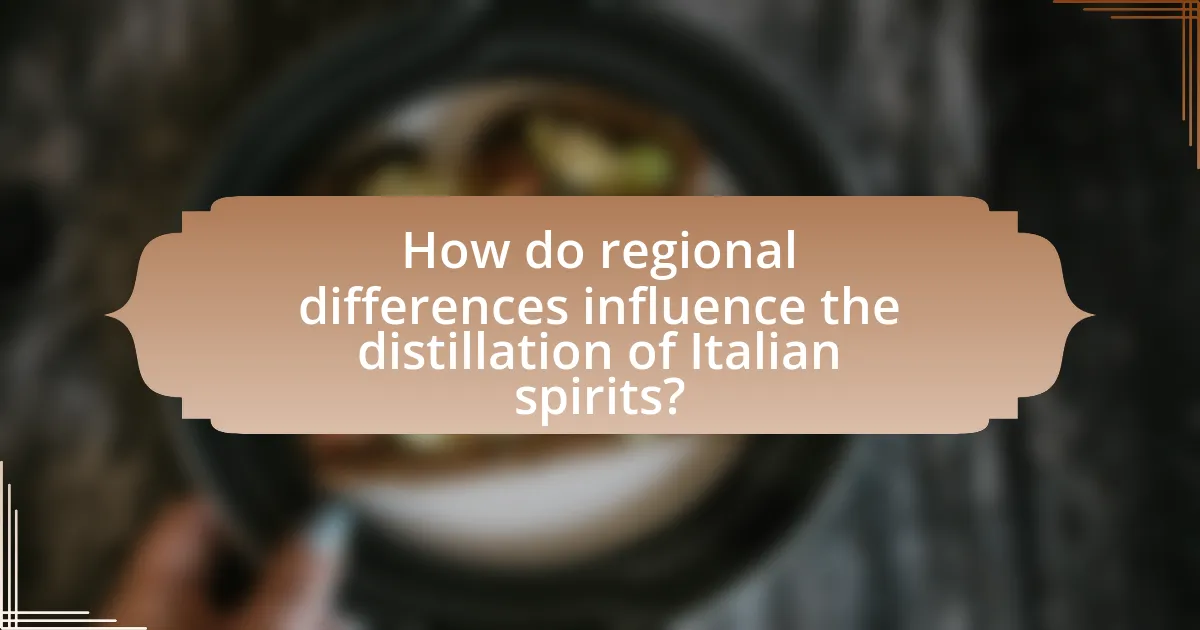
How do regional differences influence the distillation of Italian spirits?
Regional differences significantly influence the distillation of Italian spirits by dictating the choice of raw materials, production techniques, and flavor profiles. For instance, in the northern regions like Trentino-Alto Adige, the use of apples and grapes is prevalent due to the local climate and agricultural practices, resulting in spirits like Grappa and Apple Brandy. Conversely, southern regions such as Sicily utilize citrus fruits and herbs, leading to unique products like Limoncello. Additionally, traditional methods vary; for example, the use of pot stills in some areas contrasts with column stills in others, affecting the final spirit’s character. These regional characteristics are rooted in historical practices and local tastes, making each Italian spirit distinct and reflective of its geographical origin.
What are the unique characteristics of spirits from different Italian regions?
Italian spirits exhibit unique characteristics influenced by their regional origins, reflecting local ingredients, traditions, and distillation methods. For instance, in Tuscany, the production of Vin Santo involves the use of dried grapes, resulting in a sweet dessert wine with rich flavors. In the Veneto region, Grappa is made from pomace, showcasing a strong, aromatic profile that varies based on the grape variety used. Meanwhile, in Sicily, the use of citrus fruits in Limoncello creates a refreshing, zesty spirit that highlights the island’s agricultural bounty. Each region’s climate, soil, and cultural practices contribute to the distinct taste and quality of its spirits, making Italian distillation a diverse and rich tradition.
How does the local environment affect the ingredients used in distillation?
The local environment significantly influences the ingredients used in distillation by determining the availability and quality of raw materials. Factors such as climate, soil composition, and local flora directly affect the types of fruits, grains, or botanicals that can be cultivated. For instance, the Mediterranean climate in Italy allows for the growth of citrus fruits, which are often used in the production of spirits like limoncello. Additionally, the mineral content of local water sources can impact the flavor profile of the distilled product, as seen in the use of specific spring waters in the production of grappa. These environmental factors create a unique terroir that shapes the character of the spirits produced in a given region.
What traditional practices vary by region in the distillation process?
Traditional practices in the distillation process vary significantly by region in Italy, reflecting local ingredients and cultural heritage. For instance, in the northern regions like Piedmont, distillation often involves the use of grape pomace to produce grappa, utilizing traditional pot stills that emphasize the preservation of flavor. In contrast, southern regions such as Sicily focus on citrus fruits, employing continuous column stills to create spirits like limoncello, which require a different approach to extraction and flavor enhancement. These regional differences are rooted in historical practices and the availability of local raw materials, showcasing the diversity of Italian distillation methods.
How do modern techniques enhance traditional distillation methods?
Modern techniques enhance traditional distillation methods by incorporating advanced technologies such as vacuum distillation, continuous distillation, and computer-controlled processes. These innovations improve efficiency, reduce energy consumption, and allow for greater precision in temperature control, which results in higher quality spirits with more consistent flavor profiles. For instance, vacuum distillation lowers the boiling point of liquids, enabling the extraction of delicate flavors without damaging them, a significant improvement over conventional methods that may compromise quality. Additionally, continuous distillation systems streamline production by allowing for uninterrupted operation, thus increasing output while maintaining the integrity of the distillate.
What innovations are being introduced in the distillation of Italian spirits?
Innovations in the distillation of Italian spirits include the use of advanced technology such as vacuum distillation and continuous column distillation. Vacuum distillation allows for lower temperature processing, preserving delicate flavors and aromas, while continuous column distillation enhances efficiency and consistency in production. These methods are increasingly adopted by distilleries to improve quality and reduce energy consumption, reflecting a trend towards sustainability in the industry.
How do these innovations impact flavor and quality?
Innovations in distillation techniques significantly enhance the flavor and quality of Italian spirits. Advanced methods, such as vacuum distillation, allow for lower temperature processing, preserving delicate aromatic compounds that contribute to a more nuanced flavor profile. Additionally, the use of modern filtration systems removes impurities without stripping essential flavors, resulting in a smoother and more refined product. Research indicates that these innovations lead to a more consistent quality across batches, ensuring that consumers experience the intended taste and aroma with each sip.
What are some best practices for enjoying Italian spirits?
To enjoy Italian spirits, serve them at the appropriate temperature, typically chilled for lighter spirits like limoncello and at room temperature for richer options like grappa. Pairing these spirits with complementary foods enhances the tasting experience; for instance, grappa is often enjoyed with dark chocolate or strong cheeses. Additionally, using proper glassware, such as tulip-shaped glasses for grappa, helps concentrate the aromas, allowing for a fuller sensory experience. These practices are rooted in Italian culture, where the enjoyment of spirits is often a communal and gastronomic affair, emphasizing the importance of pairing and presentation.
How should Italian spirits be served for optimal flavor?
Italian spirits should be served at the appropriate temperature to enhance their flavor profile. For example, grappa is best enjoyed at room temperature, allowing its complex aromas to be fully appreciated, while limoncello is typically served chilled to accentuate its refreshing citrus notes. Serving Italian spirits in appropriate glassware, such as a tulip-shaped glass for grappa, can also concentrate the aromas, further enhancing the tasting experience. These serving methods are supported by traditional practices in Italy, where the enjoyment of spirits is closely tied to their optimal flavor presentation.
What food pairings complement different types of Italian spirits?
Italian spirits can be complemented by specific food pairings that enhance their flavors. For example, Grappa pairs well with rich cheeses like Gorgonzola or aged Parmigiano-Reggiano, as the spirit’s strong character balances the creaminess of the cheese. Limoncello, known for its bright citrus notes, is best enjoyed with light desserts such as sorbet or panna cotta, which echo its refreshing qualities. Amaro, with its herbal and bitter profile, complements savory dishes like roasted meats or dark chocolate desserts, as the bitterness contrasts with the richness of the food. These pairings are rooted in traditional Italian culinary practices, where the harmony between food and drink is essential for enhancing the dining experience.

